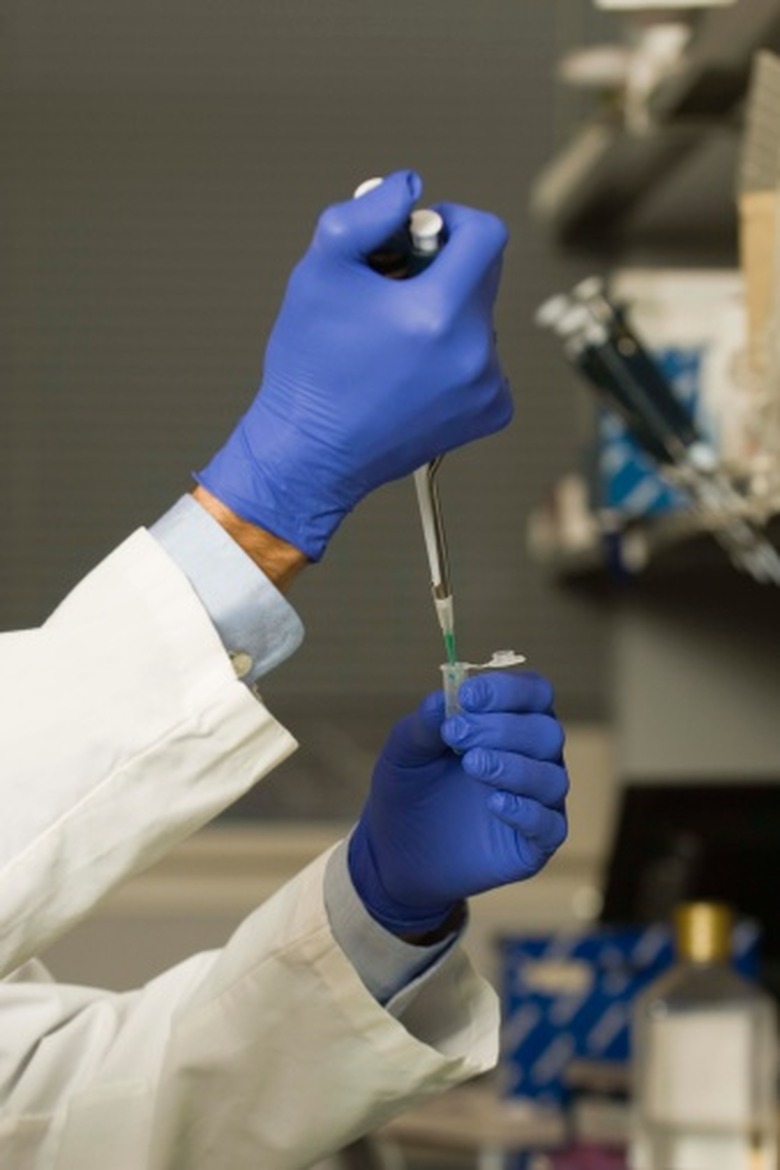How To Make A Calibration Standard For An HPLC
When working with high performance liquid chromatography (HPLC), good calibration is absolutely essential to ensure reliable, quality results. Proper calibration of an HPLC instrument begins with the making of a suitable calibration standard. In most instances, calibration in fact requires a series of standards of increasing concentration in order to produce what is known as a calibration curve. This is a plotted line and associated equation which describes the relationship between the concentration of the chemical being tested for and the response of the HPLC detector.
Step 1
Determine the chemical which you wish to test for using the HPLC (the "analyte"). For example, you might wish to test a series of soft drinks for fructose content, in which case fructose would be the analyte.
Step 2
Obtain a quantity of the analyte chemical of suitable purity. Normally purity should be above 99% and the analyte should be purchased from a reputable chemical supply company. In the case of fructose, for example, you would purchase pure fructose from a chemical vendor and not from a grocery store.
Step 3
Determine the maximum and minimum anticipated concentrations of the analyte in the samples you intend to test on the HPLC. In the case of soft drinks, you would examine the labels of the drinks and determine the lowest and highest fructose content amongst the drinks you will test. Keep in mind that the initial sample (the soft drink) may be diluted or otherwise manipulated during preparation for analysis (depending on the HPLC method being used) and so the analyte concentration in the samples actually injected onto the HPLC may be modified. It is the analyte concentration in the samples as run on the HPLC that must be considered.
Step 4
Determine the solvent in which you will dissolve your analyte to make up calibration standards. This solvent must be able to properly dissolve the analyte over a relatively wide range of concentration (at least as high as in the samples you intend to test). As well, this solvent should ideally be quite similar to the "mobile phase:" the solvent used to carry samples through the HPLC instrument.
Step 5
Calculate the amount of analyte required to make a "stock standard" solution of the analyte. This is found by multiplying the required concentration of the stock standard by the desired volume. The concentration of the analyte in this solution should be at least 10% higher than the highest anticipated sample concentration. If the highest anticipated fructose concentration in a soft drink sample is 8 grams/100 milliliters, then the stock standard could be made to a concentration of 10 grams fructose/100 milliliters. A reasonable volume is 500 milliliters, thus 8/100 mL x 500 mL = 40 grams fructose would be required.
Step 6
Weigh out the required amount of analyte to a suitable level of precision. Often a weight value in grams precise to one or two decimal places is suitable, but more precision may be necessary for some methods.
Step 7
Transfer the weighed analyte to a volumetric flask of the necessary volume and add the desired solvent to the fill mark on the flask. Use of a volumetric flask (rather than a graduated beaker, for example) increases the precision of the stock standard concentration value. Ensure that all the analyte is transferred to the flask; use some of the solvent to wash it in, if necessary.
Step 8
Stopper the volumetric flask and gently shake or invert until the analyte is completely dissolved.
Step 9
Make a series of varying dilutions of the stock standard by transferring known volumes of the stock standard into volumetric flasks, using pipettes for accurate transfer, then adding solvent. The lowest standard concentration should be below the lowest anticipated sample to be analyzed. In the soft drink example, if the lowest expected fructose concentration in a sample is 2 grams/100 mL, then a 1 gram/100 mL standard could be made. This would be made by a tenfold dilution of the stock standard. The standard series should include a total of 5 or 6 concentrations, so additional dilutions to produce standards of perhaps 3, 5 and 8 grams fructose/mL would be required. You now have a series of standard solutions with which to calibrate the HPLC.
Things Needed
- Traceable standard analyte material
- Volumetric glassware
- Pipettes
- Weigh scale
- Calculator
- Solvent
TL;DR (Too Long; Didn't Read)
It is possible to make calibration standards containing more than one analyte if required. It is often good practice to filter calibration samples (and standards) before injecting them onto the HPLC to remove any fine particulates which could plug the instrument.
Warning
Some standards degrade quickly after they are made. Ensure that your standards are replaced frequently if this is the case. As with all chemical procedures, observe proper precautions when working with potentially harmful analytes or solvents such as those which are toxic or flammable.
Cite This Article
MLA
Judge, Michael. "How To Make A Calibration Standard For An HPLC" sciencing.com, https://www.sciencing.com/make-calibration-standard-hplc-8220690/. 24 April 2017.
APA
Judge, Michael. (2017, April 24). How To Make A Calibration Standard For An HPLC. sciencing.com. Retrieved from https://www.sciencing.com/make-calibration-standard-hplc-8220690/
Chicago
Judge, Michael. How To Make A Calibration Standard For An HPLC last modified March 24, 2022. https://www.sciencing.com/make-calibration-standard-hplc-8220690/
